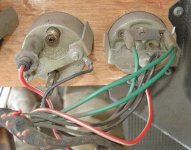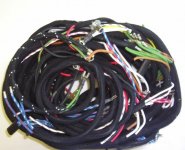My BJ8 fuel gauge indicates about 5/8s of a tank when the key is on and just over 3/4s of a tank when the engine is running regardless of fuel level. Removing the T wire results in the gauge going to empty (I thought it was supposed to go to full) and grounding the T wire results in the gauge going to full (thought it was supposed to go to empty).
I have a new moss sending unit that reads 1.7 ohms to 100.2, which I understand from Moss is within their range of acceptability. From previous posts on this forum I understand the 100.2 may be on the high side but think the difference would result in inaccurate readings rather than static ones. I had the same gauge readings with the sending unit I just replaced.
The green wire is showing 12.2 volts. I believe the ground is good on the tank and on the gauge. I have used a separate lead wire to go direct from the fuel sender T to the gauge T with the same static gauge readings.
Any ideas would be greatly appreciated. Thanks George
I have a new moss sending unit that reads 1.7 ohms to 100.2, which I understand from Moss is within their range of acceptability. From previous posts on this forum I understand the 100.2 may be on the high side but think the difference would result in inaccurate readings rather than static ones. I had the same gauge readings with the sending unit I just replaced.
The green wire is showing 12.2 volts. I believe the ground is good on the tank and on the gauge. I have used a separate lead wire to go direct from the fuel sender T to the gauge T with the same static gauge readings.
Any ideas would be greatly appreciated. Thanks George

 Hi Guest!
Hi Guest!

 smilie in place of the real @
smilie in place of the real @
 Pretty Please - add it to our Events forum(s) and add to the calendar! >>
Pretty Please - add it to our Events forum(s) and add to the calendar! >> 



